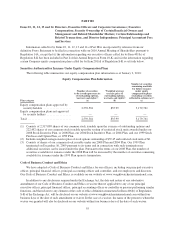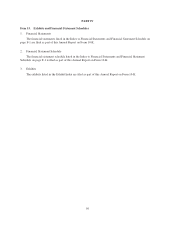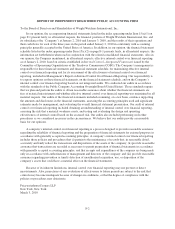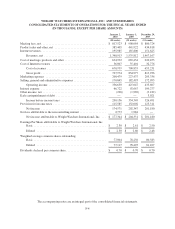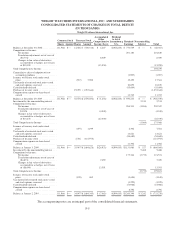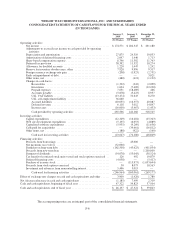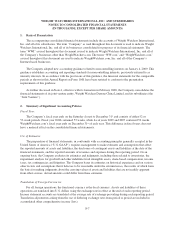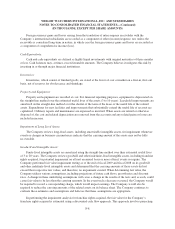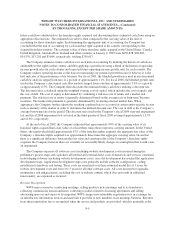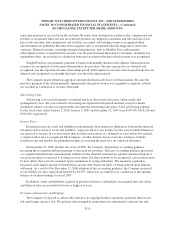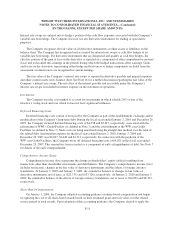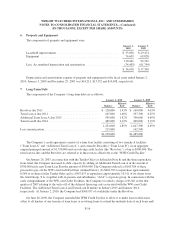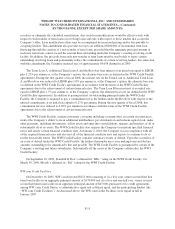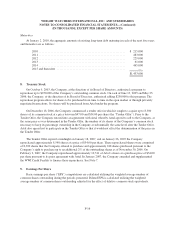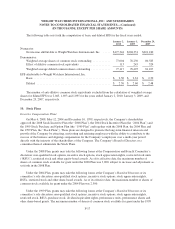WeightWatchers 2009 Annual Report Download - page 80
Download and view the complete annual report
Please find page 80 of the 2009 WeightWatchers annual report below. You can navigate through the pages in the report by either clicking on the pages listed below, or by using the keyword search tool below to find specific information within the annual report.WEIGHT WATCHERS INTERNATIONAL, INC. AND SUBSIDIARIES
NOTES TO CONSOLIDATED FINANCIAL STATEMENTS—(Continued)
(IN THOUSANDS, EXCEPT PER SHARE AMOUNTS)
Foreign currency gains and losses arising from the translation of intercompany receivables with the
Company’s international subsidiaries are recorded as a component of other (income)/expense, net, unless the
receivable is considered long-term in nature, in which case the foreign currency gains and losses are recorded as
a component of comprehensive income (loss).
Cash Equivalents:
Cash and cash equivalents are defined as highly liquid investments with original maturities of three months
or less. Cash balances may, at times, exceed insurable amounts. The Company believes it mitigates this risk by
investing in or through major financial institutions.
Inventories:
Inventories, which consist of finished goods, are stated at the lower of cost or market on a first-in, first-out
basis, net of reserves for obsolescence and shrinkage.
Property and Equipment:
Property and equipment are recorded at cost. For financial reporting purposes, equipment is depreciated on
the straight-line method over the estimated useful lives of the assets (3 to 10 years). Leasehold improvements are
amortized on the straight-line method over the shorter of the term of the lease or the useful life of the related
assets. Expenditures for new facilities and improvements that substantially extend the useful life of an asset are
capitalized. Ordinary repairs and maintenance are expensed as incurred. When assets are retired or otherwise
disposed of, the cost and related depreciation are removed from the accounts and any related gains or losses are
included in income.
Impairment of Long Lived Assets:
The Company reviews long-lived assets, including amortizable intangible assets, for impairment whenever
events or changes in business circumstances indicate that the carrying amount of the assets may not be fully
recoverable.
Goodwill and Intangible Assets:
Finite-lived intangible assets are amortized using the straight-line method over their estimated useful lives
of 3 to 20 years. The Company reviews goodwill and other indefinite-lived intangible assets, including franchise
rights acquired, for potential impairment on at least an annual basis or more often if events so require. The
Company performed fair value impairment testing as of the end of fiscal 2009 and fiscal 2008 on its goodwill
and other indefinite-lived intangible assets and determined that the carrying amounts of these assets did not
exceed their respective fair values, and therefore, no impairment existed. When determining fair value, the
Company utilizes various assumptions, including projections of future cash flows, growth rates and discount
rates. A change in these underlying assumptions will cause a change in the results of the tests and, as such, could
cause fair value to be less than the carrying amounts. In the event such a decrease occurred, the Company would
be required to record a corresponding charge, which would impact earnings. The Company would also be
required to reduce the carrying amounts of the related assets on its balance sheet. The Company continues to
evaluate these estimates and assumptions and believes that these assumptions are appropriate.
In performing the impairment analysis for franchise rights acquired, the fair value for the Company’s
franchise rights acquired is estimated using a discounted cash flow approach. This approach involves projecting
F-8



